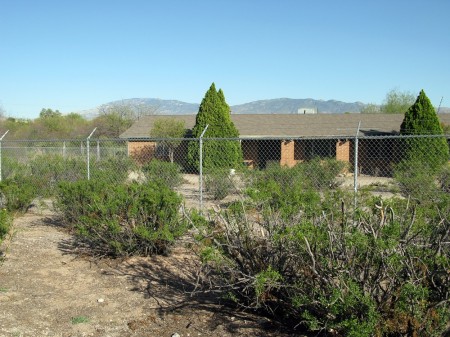Donna and I have now stayed in one place longer than either of us ever stayed anywhere before: nearly 14 years in Tucson; nearly 13 years in the same house. Not bragging … almost any normal American (one who did not grow up in a military or transient family, that is) can easily beat our record.

But that’s not want I want to blog about this morning. I want to blog about our neighborhood mystery house. Less than a mile from here, separated from nearby homes by a few acres of desert scrub, sits a solitary house … a house with a difference.
Perhaps you can see the difference in the photo above. Yes, the barbed wire points in, not out. What you can’t see, mainly because I was too timid to loiter out front in order to take better photos, are the burglar bars over all the windows and doors. Nor can you see, because it is no longer there, the coils of concertina wire that used to stretch along the top of the fence.
It’s more than a house, it’s a fortress … a fortress designed to keep something in, not out. Here’s some additional detail:

The mystery house is on the road we drive to and from our house, and we pass it every day. During all that time we’ve never seen who lives there. In fact, we’ve never seen anyone at all. There’s never been a car in the driveway, nor has there ever been anyone inside the fenced yard. Lately we’ve been looking harder, and we think the house is now empty. One indication of that, as noted above, is the missing concertina wire, which was there until just a few months ago. Nor do there seem to be drapes behind the windows.
So … is, or was, there a Thing! in my own neighborhood? I don’t think so. Here’s what I think:
A few years ago homeowners in our subdivision were riled up over the presence of a nearby group home for teenagers with Prader-Willi Syndrome. That’s the condition that causes constant hunger, whose sufferers never feel they’ve eaten enough.
What our neighbors were upset about was that the kids who lived in the home would occasionally elude their caregivers and get out. When they broke out they’d roam, sometimes into our subdivision, looking for food. Since another symptom of Prader-Willi Syndrome is decreased mental capability, these kids had no inhibitions about wandering into peoples’ homes to raid refrigerators. I never saw them, but I would sometimes see Pima County Sheriff cars slowly cruising our street, looking for Prader-Willi home escapees.
Some members of the homeowners’ association wanted the group home shut down and relocated to another neighborhood. We invited a representative of the Arizona Prader-Willi Syndrome Association to attend a homeowners’ meeting to tell us about the home and how the kids were supervised. The spokesman explained that the kids were constantly, ravenously hungry, always thinking of ways to get out and look for food. He admitted that no matter how vigilant the caregivers were breakouts sometimes happened. When the kids got loose the caregivers called the Pima County Sheriff division, whose personnel knew about the kids and the places they’d likely go, where they’d find them and round them up. He also explained that the kids were generally passive and had never harmed anyone.
Donna and I refused to join the NIMBY chorus. Clearly, supervised care in a group home … a home without a kitchen, where a limited amount of food is brought in at mealtimes … is what these kids need, and the home has to be somewhere, right? In fact, our neighborhood is the ideal one for such a home: relatively isolated, one- to three-acre lots, three miles to the nearest stores. Live and let live, and be thankful our children don’t suffer from what sounds like a perfectly awful disease.
In all that time, I never made the connection between the mystery house and the Prader-Willi Syndrome group home, but I bet that’s what the mystery home is … or was, since it now appears to be empty. I hope it wasn’t my neighbors who ran them away.
Then again, the Munsters had kids too, didn’t they? Maybe some of them grew up and moved to Tucson, Arizona. That would also explain our mystery house.